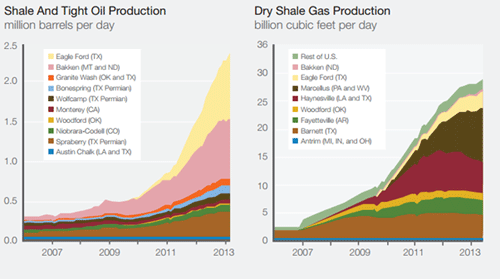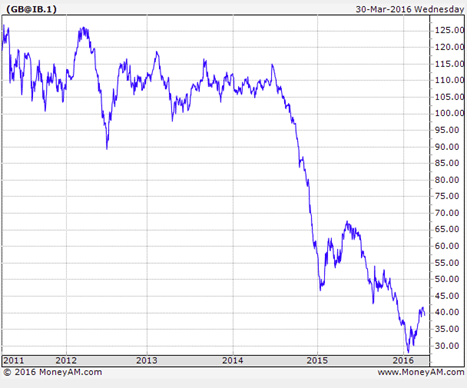The story in the oil market right now is all about supply. Or to be more accurate, it’s a fight between suppliers. There was a time when the dynamic was totally different – when the handful of nations who control the majority of the world’s supply could essentially hold the rest of the world ransom and drive the price up. That’s all changed. Now, it’s suppliers who are fighting among themselves to keep market share.
That’s how most people are looking at the story, anyway.
But what if that’s not what’s really going on? What if this isn’t a story about oil producers and oil consumers – traditional supply and traditional demand – at all?
There’s an alternate view here. And it’s that what we’re seeing in the oil market is really a battle between disruptors and disruptees. It’s really a story about technology and creative destruction.
This is the engine at the heart of a capitalist economy. The gales of creative destruction killing off the old and the inefficient and replacing them with new and better ways of doing things.
Think about it like this. Conventional thinking tells you that everyone needs oil, right? It’s the world’s number one source of energy. It’s the fuel that keeps planes in the sky, cars on the road and the economy humming along. It’s the incumbent. The companies and countries that produce it are often both wealthy and powerful.
It’s hard to imagine this supremacy being challenged.
At least, for a long time it was. But just look at the way a new technology – mainly hydraulic fracturing (fracking) – has disrupted the industry.
Ten years ago very few people outside the oil and gas industry had heard of fracking. That all changed in the middle of the last decade. Shale and tight oil product exploded out of nowhere to become a major source of supply (particularly in the USA). The chart below tells the story of tight oil supply expanding at a rapid pace:

Source: https://www.eia.gov/todayinenergy/detail.cfm?id=13451
This – as you’d expect – signalled a real boom time for shale and tight oil companies.
And as the new supplies of shale and tight oil came on stream, they disrupted the balance of supply and demand in the oil market. Perhaps more importantly they threatened traditional oil suppliers like Opec. That’s what triggered a price war as Opec – led by the Saudis – flooded the market with even more supply in an attempt to wrest market share away from shale and tight oil producers.
You probably know how this story ends. But I’ll throw a chart your way just to make double sure.

The price of oil cratered. That’s had a knock on effect across the whole industry, with over-indebted producers reportedly teetering on the brink, share prices hammered across the board and whole countries suffering from a revenue shortfall brought about by the collapse in prices.
You may well have heard that Venezuela is careering towards bankruptcy, as its overreliance on oil has been laid bare.
But even the mightiest oil power – Saudi Arabia – has been in difficulty too.
Consider:
- In July 2015 Saudi had to borrow money from abroad for the first time since 2007.
- The country had to spend $115 billion of its reserves in 2015. If the oil price stays where it is now, its reserves will be gone within five years.
- It has had to withdraw troops from the war in Yemen – which is reportedly costing it $172 million per week – to try and balance its budget.
Or to put it another way:
New technology has emerged that threatens to disrupt an entire industry… even an entire way of life for some people.
Disruptive technology creates winners and losers. The rich and the powerful can lose out just as easily as anyone else if they’re unprepared for what’s happening.
The disruption we’ve seen in the oil market so far was triggered initially by an emerging technology – fracking. It’s radically upset the market. But it’s a
technology that allows us to access more of the same – more oil, more gas.
What would happen if a new source of energy could replace oil altogether?
What if something emerged as a genuine contender for the world’s number one fuel source, removing millions – perhaps billions – of dollars of demand for oil?
What would happen to the high and mighty of the energy world – the countries that have gone “all in” on oil and gas – like Saudi Arabia, Russia, Qatar and the like?
I think I have the answer. And I’ve prepared a presentation explaining exactly how it could play out and what you need to do to take advantage. It’s called “Fall of the House of Saud”.
Category: Economics

